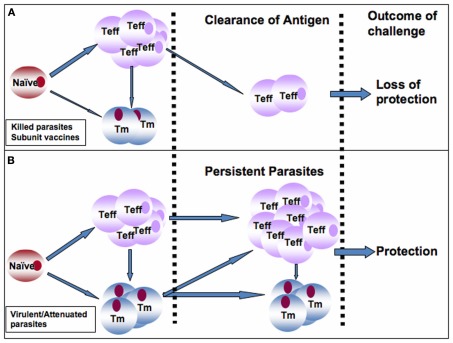Figure 1.
Proposed model to explain the superior protective immunity induced by infection or vaccination with live-attenuated live parasites over those induced by killed parasites and subunit vaccines. (A) Following vaccination with killed or subunit vaccines, a robust effector T cells (Teff) are generated from naïve Leishmania-specific T cells at the expense of memory T (Tm) cells. It is plausible that some Teff cells could also convert into Tm cells. In the absence of persistence antigen (as seen following antigen clearance), the Teff cells are rapidly depleted leading to loss of immunity and susceptibility to secondary virulent challenge. (B) In contrast, infection with virulent parasites or vaccination with live-attenuated or genetically modified parasites leads to generation of robust and balanced Teff and Tm cells, infection-induced immunity, and persistence of low number of parasites at the infection site and its draining lymph node. Persistent parasites promote constant generation and maintenance of Teff and Tm cells in the draining lymph node leading to maintenance of immunity and protection against secondary virulent challenges. This would eliminate the need for frequent booster immunizations.

